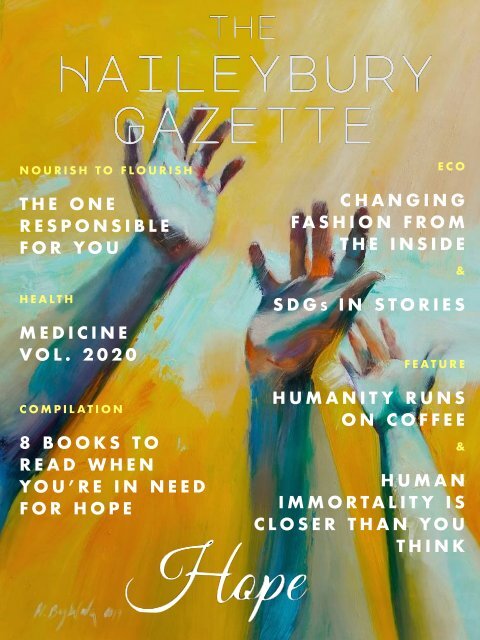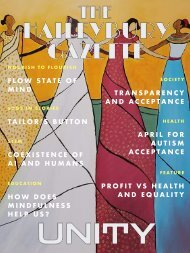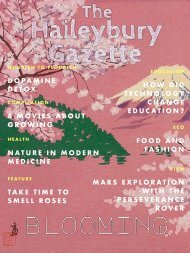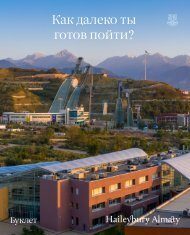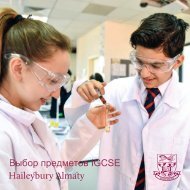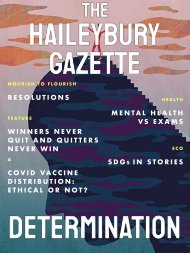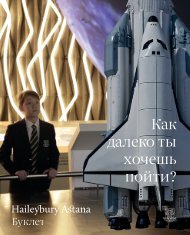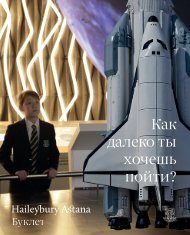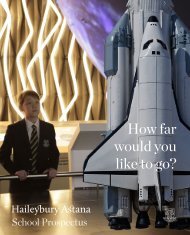Haileybury Gazette | Hope | Issue 9
You also want an ePaper? Increase the reach of your titles
YUMPU automatically turns print PDFs into web optimized ePapers that Google loves.
NOURISH TO FLOURISH<br />
THE ONE<br />
RESPONSIBLE<br />
FOR YOU<br />
HEALTH<br />
MEDICINE<br />
VOL. 2020<br />
COMPILATION<br />
8 BOOKS TO<br />
READ WHEN<br />
YOU’RE IN NEED<br />
FOR HOPE<br />
ECO<br />
CHANGING<br />
FASHION FROM<br />
THE INSIDE<br />
SDGS IN STORIES<br />
FEATURE<br />
HUMANITY RUNS<br />
ON COFFEE<br />
HUMAN<br />
IMMORTALITY IS<br />
CLOSER THAN YOU<br />
THINK<br />
&<br />
&
LETTER<br />
FROM THE<br />
EDITOR<br />
Ladies, gentlemen, and non-binary folk,<br />
Hardships require strength and determination to overcome them, that in turn need the fuel of<br />
hope. It takes effort to act in a way that builds and sustains life you want to create. This is why I<br />
wish for your choices to reflect your hopes, not your fears.<br />
<strong>Hope</strong> is a powerful force. There is no magic involved. Unless, of course, you consider the light<br />
hopefulness brings, that gives you the strength to make things happen to be magic.<br />
As said by Barbara Kingsolver, “the very least you can do in your life is to figure out what you<br />
hope for. And the most you can do is live inside that hope. Not admire it from a distance but live<br />
right in it, under its roof.” Trust in yourself, your dreams and your efforts. Take a leap of faith in<br />
being bold enough to pursue your goals.<br />
And I know that it is tough, especially with everything happening in the world right now. But I<br />
want you to trust me on this one - you have enough strength in you to be full of hope. Because<br />
you deserve the world you hope for. Enjoy the process of becoming a person who embraces the<br />
courage of aspiration.<br />
Love,<br />
Erko<br />
2
TABLE OF CONTENTS<br />
2<br />
3<br />
4-6<br />
6-8<br />
9-10<br />
11-12<br />
13-18<br />
19-21<br />
22-24<br />
LETTER FROM THE EDITOR<br />
TABLE OF CONTENTS<br />
NOURISH TO FLOURISH: HOW TO STOP<br />
OVERTHINKING: THE GUIDE<br />
INTERVIEW: FROM THE LEADER OF THE<br />
TUTORING CLUB<br />
HEALTH: SAY YES TO YOGA!<br />
ECO: ACT! THE ECO COMMITTEE<br />
FEATURE: ONLINE MUN EXPERIENCE<br />
EDUCATION: STUDY GUIDE FOR MOCKS<br />
HEALTH: BENEFITS OF GRATITUDE<br />
3
THE ONE<br />
RESPONSIBLE FOR YOU<br />
BY ANUAR K<br />
NOURISH<br />
TO<br />
FLOURISH<br />
One of the main privileges that the 21st century has presented to the modern world is the<br />
ever-effective and accessible world of medicine. Back in the old days, even the richest of<br />
kings lacked the same access to medicine, that an ordinary citizen of the developed world<br />
now has. In the last century, the life expectancy of an average person has risen from 30 to<br />
70 years of age. But the skepticism of modern medicine has caused many physicians and<br />
pharmacists to argue that the number could be even higher if “people just took their damn<br />
pills”.<br />
The mistrust of modern medicine is a<br />
widespread problem caused by a<br />
plethora of different factors. Many<br />
people are simply frightened by the<br />
potential side effects that their<br />
treatment can carry. Others are more<br />
preoccupied with the cost of medicine,<br />
believing that most doctors’ objective is<br />
not the wellbeing of the patient, but<br />
rather the selling of as many products as they possibly could. Whatever the reasoning behind<br />
this mindset, the end result is patients who don’t take their prescription medication properly.<br />
However, the same people accused of neglecting personal health, when found responsible<br />
for their pets’ well being - be it a dog, cat or a capybara - tend to take care of them in a<br />
much more punctilious manner than they take care of themselves.<br />
Despite having just as much rationale to distrust a veterinarian as much as a normal<br />
physician, when it comes to people administering the proper medication to their beloved<br />
pets, they are far more diligent. You may ask yourself, why? Well as stated above, there<br />
aren’t any obvious reasons as to why a standard doctor might have more malicious intentions<br />
than a veterinarian. Furthermore, if you never really cared about your pet to inquire about<br />
the possibility of harmful side-effects or substandard quality of the medication, then you<br />
would have never even taken them to the vet in the first place. Thus, the logical conclusion is<br />
that you simply care for your pet more than yourself. This is the main reason as to why<br />
people are better at administering prescription medication to their pets.<br />
4
The idea that we take better care of others than ourselves, is not just limited to pets. The<br />
same behavior often extends to the people around you. This is due to the phenomenon that<br />
it is much easier to see others as more virtuous beings than ourselves, thus making it much<br />
easier to care for them. For example, take your dog - you always viewed it as a creature that<br />
will be a loyal and loving companion to you, no matter what. You on the other hand, are a<br />
very complicated being with many flaws and weaknesses. Why on earth would you deserve<br />
better care than your pet? This idea is very common in people with self-esteem issues, who<br />
tend to disregard things, even if they are good for us, because they believe that they don’t<br />
deserve them. This harmful idea plagues many people throughout the world, and one way to<br />
stop it is by adopting the notion of “treating yourself, like someone you are<br />
responsible for helping”.<br />
Well it’s one thing to say it, it's another thing to do.<br />
How exactly do you go about this philosophy? Think of<br />
a parent-child relationship. Parents are faced with<br />
a never-ending barrage of pleas from their children, for<br />
example, to buy more toys, or to skip school. Whilst it<br />
could be incredibly hard to not give in to these constant<br />
demands, parents have to stand their ground. If you do<br />
give in, you may make them temporarily happy, but this<br />
decision will have its set of dire consequences to come.<br />
The toy and candy will eventually bore them and soon<br />
they will want more. By not going to school, you are subduing their potential as an<br />
individual. So in order to truly treat yourself like someone you are responsible for, adopt the<br />
same mindset that a parent would to his child: resist the empty and superficial<br />
desires. Make ambitious goals that truly represent what you want in life.<br />
Discipline yourself carefully, work hard and reward yourself accordingly.<br />
5
There often comes a time in a<br />
person's life when it feels like all of<br />
your ambition and determination has<br />
run its course and been depleted.<br />
You get stuck in this state of<br />
indifference, losing all your previous<br />
zest and motivation. For some, this<br />
can last from a couple of days to<br />
months on end and escaping the<br />
talons of this ‘humdrum existence’ is<br />
not a very easy undertaking. But<br />
when people finally decide to stand up against the tide of life and take the reins of their life,<br />
they often set themselves up for failure. They create ambitious and unrealistic goals. They<br />
make schedules that leave hardly any free time and fill it with non-stop work. What they don't<br />
realize is that this is a trap. How are you supposed to muster the self discipline and a neverbefore-seen<br />
adherence to a work ethic out of nowhere? You don’t, it's impossible. What ends<br />
up happening, of course, is that you don't end up matching the expectations. You give up<br />
after a few days and after you give up you recede back to your old self.<br />
Is this how you would treat a person you’re responsible for? No, you wouldn’t. Take for<br />
example, your pet; in order to instill a new skill or a trick in a dog, you must always reward it<br />
with a treat as affirmation for their work. Act in a similar way. For all your hard work -- give<br />
yourself a treat -- it doesn’t have to be a literal one, but it has to be something you enjoy.<br />
Don’t just pile up work on work on work. It’s unsustainable. Instead, be honest with yourself,<br />
make goals that are realistic and never forget to reward yourself.<br />
“Start with yourself. Take care of yourself. Define who you are.<br />
Choose your destination.” These are the words of Jordan<br />
Peterson, an acclaimed author and a clinical psychologist, who<br />
created the theory of “treating yourself like some you are<br />
responsible for helping”.<br />
Post scriptum: if you find this advice particularly helpful, I would<br />
recommend reading Jordan Peterson’s book “12 Rules For Life”.<br />
It contains much useful advice on how to navigate this world, which<br />
partially inspired this article.<br />
Jordan Peterson<br />
6
CHANGING FASHION<br />
FROM THE INSIDE<br />
ECO<br />
THE FASHION REVOLUTION MOVEMENT<br />
BY ERKO S<br />
Aruzhan Akchanova is a senior studying<br />
Textile Design at Central Saint Martins<br />
University, London. She is a <strong>Haileybury</strong><br />
Almaty alumna working in the Fashion<br />
Revolution Kazakhstan team.<br />
“I graduated from <strong>Haileybury</strong> Almaty in 2017<br />
and had the pleasure of being a Head Girl<br />
and contributing towards such a progressive<br />
school. I was thrilled when I found out that<br />
<strong>Haileybury</strong> is taking a step towards<br />
incorporating more sustainable practices.<br />
Central Saint Martins University<br />
Fashion and textiles play a vital role in our everyday lives, even in today’s world – we wear<br />
textiles as face coverings every day. Ever since I was a kid, I was into anything that involved<br />
being creative and innovative. This interest soon progressed into fascination with different<br />
materials and the possibilities behind them. Studying textiles and art during my A-Levels at<br />
<strong>Haileybury</strong> Almaty was the beginning of an exciting journey that led me to getting a place at<br />
one of the top fashion universities in the world. Getting into such a globally renowned<br />
college and being surrounded by so many talented minds made me realize how important it<br />
is to be not only an innovative designer, but also a more conscious one. Implementing<br />
sustainability into my creative practice led to discovering and joining the Fashion Revolution<br />
Kazakhstan team.”<br />
7
WHAT IS THE FASHION REVOLUTION AND HOW<br />
WAS IT BORN?<br />
Eight years ago, the glossy facade of the global fashion<br />
industry was shattered following the collapse of the Rana<br />
Plaza factory in Bangladesh. The eight-storey garment factory<br />
collapsed after the upper four floors were built without<br />
permission, becoming the deadliest garment-factory disaster<br />
to ever occur. In addition to more than 1300 killed, 2515<br />
people were injured. Many of the survivors had been trapped<br />
under tons of rubble and machinery for hours or even days.<br />
Material: Plastic Bags<br />
SDG12: Responsible<br />
Consumption and Production<br />
(reduce single use items)<br />
Workers at the garment factory manufactured items for major<br />
fashion outlets including Benetton, Bonmarché, Mango,<br />
Matalan and Primark. The incident generated an international<br />
outcry about workers’ safety, workplace conditions and<br />
labour rights, resulting in extensive coverage in international<br />
media through the #WhoMadeMyClothes campaign. It<br />
encouraged shoppers to ask more questions and for retailers<br />
to do more to seek out sustainable solutions. The Fashion<br />
Revolution Movement was established two years later. Its<br />
purpose is to encourage conversations about how the fashion<br />
industry can improve ethically and sustainably around the<br />
world.<br />
Today, the goals and efforts of the movement coincide with the global sustainable goals of<br />
the United Nations, which the organization adopted in 2015 with focus on transition to<br />
sustainable consumption and production models.<br />
“We campaign for a clean, safe, fair, transparent and<br />
accountable fashion industry. We do this through research,<br />
education, collaboration, mobilisation and advocacy,” -<br />
We consume too much and too<br />
fast. Over the past 15 years,<br />
clothing sales around the world<br />
have doubled, while the<br />
average life of clothing has<br />
fallen sharply. On average, we wear something for less than a year. And if it requires repair<br />
- even less. Extremely high demand in consumption is due to low prices for consumers, but<br />
the cost to the environment of our extravagance is enormous. The amount of CO2 emissions<br />
from the textile industry annually amounts to more than a billion tons. To top it off, there is<br />
also pollution of the world's oceans with microplastics from textile fibers and the use of toxic<br />
chemicals. All in all -- we have too many clothes that we do not use for long enough. The<br />
price tag does not reflect the true cost of making them. Many garment workers do not even<br />
receive living wages!<br />
Fashion Revolution<br />
8
One way<br />
to make the garment industry<br />
more environmentally friendly is the socalled<br />
waste-free economy -- circular<br />
economy.. Ideally, such a scheme would<br />
only employ renewable energy sources.<br />
But to ensure a waste-free economy we<br />
need to stop producing waste in the first<br />
place and reduce how much we consume.<br />
So review your shopping habits and avoid<br />
the temptations of following instant trends<br />
and seeing clothes as momentary<br />
pleasure. Reduce. Reuse. Repurpose.<br />
Recycle.<br />
Material: second hand kimonos<br />
SDG10: Reduce Inequalities<br />
Fashion Revolution Week is a global event that takes place every year in the week coinciding<br />
with 24 April, the anniversary of the Rana Plaza disaster in Bangladesh. This year, Fashion<br />
th<br />
Revolution Kazakhstan is excited to collaborate with <strong>Haileybury</strong> Almaty in order to raise<br />
awareness about the importance of sustainable and ethical practices when it comes to our<br />
role as consumers, designers and decision makers because we are the future.<br />
To give clothes and textiles meaning beyond beauty and<br />
functionality. To use them as tools for progressive dialogue<br />
promoting sustainability and mindfulness. We encourage you to<br />
visualize the SDGs and/or the Eco School themes (Energy,<br />
Climate Change, Waste, Health and Wellbeing) in creating<br />
sustainable items, clothes, textiles, displays or illustrations for the<br />
fashion exhibition during the Fashion Revolution week. The<br />
Fashion Revolution Kazakhstan are going to be the judges,<br />
awarding The Most Thoughtful Contribution.<br />
Material: newspaper<br />
SDG13: Climate Action<br />
(raising awareness and knowledge)<br />
9
HOW TO START?<br />
• BRAINSTORM<br />
◦ What SDGs or Eco School themes do you want to tell the world about? What<br />
would your main message be?<br />
• PLAN<br />
◦ What medium do you want to create in? Would you like to make a textile display,<br />
accessory, clothing, illustration or something else?<br />
◦ What materials are available to you? What can you recycle? Is there anything<br />
“unconventional” you might want to use?<br />
◦ Prepare your materials<br />
• ACT<br />
◦ Draw the outline…<br />
◦ … And create!<br />
If you need help, do not hesitate to reach out. Mrs Jacoby, a<br />
professional designer and sustainability coordinator at our school,<br />
is offering online surgeries to guide/help the students with their<br />
designs.<br />
Material: eg. glass, photos, bedcloth<br />
SDG11/5: Sustainable cities and communities<br />
(heritage, generations, pollution)<br />
10
MEDICINE VOL. 2020<br />
HEALTH<br />
BY AIDANA A<br />
HOW DO WE DEFINE THE WORD ‘MEDICINE’?<br />
We perceive the term ‘medicine’ in all societies past and present. Yet, the nature of medicine<br />
varies so significantly from place to place and time to time that it’s difficult to offer a single<br />
answer.<br />
When we think of the word medicine, usually the first idea that strikes our mind is a curative<br />
thesis: to cure the sick. Curing the sick is the core medical competence. However, according<br />
to the historian of medicine Roy Porter, “the position of medicine in society has had and still<br />
has little to do with its ability to make people better/cure”. Moreover, the efficacy of<br />
medicine for improving world health has been broadly questioned by famous historians and<br />
epidemiologists (i.e. people who study or are experts in the branch of medicine which deals<br />
with the incidence, distribution, and possible control of diseases). So if we believe that the<br />
curative thesis is true, then it suggests that most medication from the beginning of time isn’t<br />
medicine in any way. In the past, much medicine was and is ineffective and inadequate or in<br />
the best-case scenario, somewhat successful. This thesis prompts a dismissive attitude towards<br />
the past endeavours upon which any current medicine is fabricated.<br />
11
However, the inquiry thesis covers more aspects of the word. As it acknowledges that the<br />
goal of medicine is a cure but states that its core business is understanding more fully and<br />
engaging the undertaking project to comprehend the nature and causes of health and<br />
disease. This approach is fairer and more appropriate to use. Hence if you searched up the<br />
word medicine on the internet now, the definition will be ‘the science or practice of the<br />
diagnosis, treatment, and prevention of disease (in technical use often taken to exclude<br />
surgery)’.<br />
AMAZING BREAKTHROUGHS IN MEDICINE<br />
To sum up, 2020 has been a turbulent year. From a medical perspective, it has been turned<br />
upside down with a lethal worldwide pandemic reorienting our daily routine and goals. Yes,<br />
it has been challenging and devastating for many of us, however, the pandemic shouldn’t<br />
obscure a time of great medical innovation. Life-changing developments in oncology, gene<br />
therapies, heart health, and most importantly, the development of COVID-19 vaccines that<br />
are being distributed around the world were discovered last year.<br />
1. ‘THE YEAR OF THE GENETIC CODE’<br />
In October 2020, Emmanuelle Charpentier and Jennifer A.<br />
Doudna were awarded the Nobel Prize in Chemistry for<br />
discovering the CRISPR/Cas9 genetic scissors. The gene<br />
’scissor’ tool is when enzymes ‘snip out pieces of DNA to<br />
restore them to their normal function’. They demonstrated<br />
that the genetic tool could be controlled to cut any kind of<br />
DNA molecule at a designated location. According to the<br />
Nobel Prize’s official announcement, this implies that we can<br />
‘change the code of life’. This development could potentially<br />
change and prevent a wide range of genetic conditions.<br />
2. HEART DISEASE AND STROKE RESEARCH.<br />
Recently, the American Heart Association released its list of innovations<br />
in medical treatments. One of the key developments is that there is a<br />
better way to treat hypertrophic cardiomyopathy (when the heart<br />
muscle thickens and can stiffen). Besides, there will be new treatments<br />
to prevent stroke and a new trial that will uncover better treatments for<br />
coronary heart disease.<br />
12
3. ONCOLOGY ADVANCEMENTS<br />
“2020 has been a year that has seen cancer research push forward on multiple fronts”<br />
stated Benjamin Neel, MD, Ph.D., director of Perlmutter Cancer Center at NYU. He said that<br />
new technologies for the early detection of cancer via blood tests are being developed. Their<br />
current research is tied in with building up the technology to monitor tumors and conduct<br />
sensitive tests for tumors and recurrence of cancers. As it has been a while that tumors<br />
release DNA into the bloodstream. Researchers have been developing better approaches for<br />
drugging genetic mutations.<br />
4. A BLOOD TEST FOR ALZHEIMER’S DISEASE<br />
More than 5 million people are living with Alzheimer’s in the USA only and according to the<br />
Centres for Disease Control and Prevention this number will triple by 2060. This year there<br />
may be a discovery in Alzheimer’s disease research and treatment. The fundamental thought<br />
is to diagnose the progressive form of<br />
dementia in the form of a blood test. Although<br />
the testing is in the trial phase, it is still huge<br />
news for our society. Despite the fact that this<br />
test must be approved, one company has<br />
distributed an Alzheimer's blood test this fall.<br />
5. COVID - 19 VACCINATION<br />
When we first encountered COVID-19 in 2019 we didn’t know much about it. Yet, in one<br />
year, there has been remarkable progress. Several vaccines are showing promise. New<br />
diagnostic tests have emerged. Doctors all over the world are battling against the virus. And<br />
a powerful way to reduce the spread -- wear a mask!<br />
As 2021 comes we are anticipating a promising new year. While many think this year was<br />
loaded with grievous and misfortunes, looking back at these developments demonstrates to<br />
us that there’s continually something to be grateful for. <strong>Hope</strong>fully, the situation will improve<br />
soon.<br />
13
HUMANITY RUNS ON<br />
COFFEE<br />
FEATURE<br />
BY ALIKSENIIA M<br />
"I stop drinking coffee, I stop doing the standing and<br />
walking and the words-putting-into-sentence-doing."<br />
— Lorelai Gilmore<br />
COFFEE DEFINITION:<br />
noun /ˈkɒfi/<br />
a magical substance that turns "Leave me alone or die" into "Good morning!"<br />
HOW DOES COFFEE AFFECT CULTURES?<br />
HISTORY AND ADAPTATION<br />
According to the National Coffee Association, coffee is<br />
the most consumed beverage aside from water. For most<br />
people, coffee marks the start of and then continues to get<br />
us through the day. How did the beverage grow into the<br />
cultural phenomenon it is today?<br />
Legend has it, coffee was discovered centuries ago by an<br />
Ethiopian farmer, Kaldi, who observed his goats eating the<br />
coffee cherries and exhibiting strange, exuberant and excessively active behavior. After the<br />
stimulating effect was discovered, coffee cherries and their beans began being passed across<br />
the globe. The beverage spread, gaining popularity. Different regions around the world<br />
began growing and cultivating coffee. In the 1600s, coffee took over as the favored<br />
breakfast beverage, replacing wine and beer.<br />
As consumption patterns changed over the years, so did consumer expectations.<br />
By the 1970s, the term “specialty” coffee came in, and an interest in knowing<br />
and distinguishing between different coffee-growing regions began to take hold.<br />
Coffees with a single-origin profile became popular, such as our Private Reserve<br />
Brazil Santos Bourbon, which features the rare yellow Bourbon variety of Arabica<br />
beans which is known for its smooth, mellow flavor. Other coffees blended a<br />
variety of regions to create skillfully crafted flavors, like the Private Reserve<br />
Founder’s Blend.<br />
14
MODERN DAY CONSUMPTION<br />
Today, coffee has become an important<br />
part of societal norms. The “coffee<br />
break” during working hours helps<br />
sustain energy throughout the day. It is<br />
also a focal point for entertaining and it<br />
creates a social ambiance. Let’s be<br />
honest, what is the most reminiscent<br />
place in the “Friends'' series? That’s<br />
right, the Central Perk.<br />
Coffee drinkers love to socialize over their favorite drinks of choice,<br />
which expanded beyond simply brewed coffee, to also include<br />
specially-crafted espresso drinks. Coffee houses have been around for<br />
more than 500 years, but the explosion of coffee house locations since<br />
the 1990s is undeniable. Culture is inherently infused in coffee,<br />
and coffee houses help create the coffee culture experience.<br />
The beverage is easily adapted in any cultural context. It brings<br />
together communities. That’s why Cap Saurage, founder of Community<br />
Coffee Company, named the brand out of appreciation for his<br />
community of friends and customers. He wanted to celebrate those he<br />
served. Coffee connects us all.<br />
HOW DOES COFFEE AFFECT OUR BODY?<br />
1.CENTRAL NERVOUS SYSTEM<br />
Caffeine acts as a stimulant. When it reaches your brain, the most<br />
noticeable effect is alertness. You’ll feel more awake and less tired,<br />
so it’s a common ingredient in medications to manage ongoing<br />
fatigue, headaches, and migraines.<br />
Studies have also found that people who drink coffee regularly have<br />
a lower risk of developing Alzheimer’s and dementia, and<br />
decrease suicide risk by 45%. These benefits are limited to<br />
people who drink high-octane (strong) coffee, not decaf. Some<br />
people consider coffee to be a health drink, but like most foods,<br />
overconsumption may lead to various side effects.<br />
15
For example, too much caffeine can give you headaches. This is primarily linked to caffeine<br />
withdrawal. The blood vessels in your brain become used to caffeine’s effects so if you<br />
suddenly stop consuming caffeine, it can cause a headache. Other symptoms of caffeine<br />
withdrawal include:<br />
• anxiety<br />
• irritability<br />
• sleepiness<br />
• tremors (rhythmic shaking movement<br />
in one or more parts of your body)<br />
• achy muscles<br />
Although it’s extremely rare, it’s also possible to overdose on caffeine. Symptoms of an<br />
overdose include:<br />
• confusion • hallucinations • vomiting<br />
An overdose of caffeine may cause rapid or irregular heartbeat and breathing trouble. In<br />
rare cases, caffeine overdose can result in death due to convulsions (an episode in which you<br />
experience rigidity and uncontrolled muscle spasms along with altered consciousness) or<br />
irregular heartbeat. Overdosing happens by consuming large amounts of caffeine, most<br />
often in energy drinks or diet pills, not coffee, so don’t worry, you will live. Up to 400<br />
milligrams of caffeine is considered to be safe, according to the Mayo Clinic. This equals<br />
about 4 cups of coffee.<br />
2. DIGESTIVE AND EXCRETORY SYSTEMS<br />
Caffeine increases the amount of acid in your stomach and may cause<br />
heartburn or upset stomach. Extra caffeine doesn’t get stored in<br />
your body either. It’s processed in the liver and exits through your urine.<br />
This is why you might have an increase in urination shortly after having<br />
caffeine.<br />
16
3. CIRCULATORY AND RESPIRATORY SYSTEMS<br />
Caffeine is absorbed from your stomach. It reaches its highest<br />
levels in your bloodstream within an hour or two. Caffeine can<br />
make your blood pressure go up for a short time. This effect is<br />
thought to be attributed to either an increase in adrenaline<br />
or a temporary block on the hormones that naturally<br />
widen your arteries. In most people, there is no long-term effect<br />
on blood pressure.<br />
4.SKELETAL AND MUSCULAR SYSTEMS<br />
Caffeine in large amounts may interfere with absorption and<br />
metabolism of calcium. This can contribute to bone thinning<br />
(osteoporosis). If you consume too much, caffeine may also cause your<br />
muscles to twitch.<br />
THE QUESTION STILL REMAINS - IS COFFEE BAD FOR YOU?<br />
Coffee isn't bad for you, as long as you drink it in moderation. Coffee can have many health<br />
benefits, such as boosting energy, providing essential nutrients, and reducing your risk for<br />
long-term health problems like heart disease or type 2 diabetes. However, coffee can be<br />
unhealthy if you drink too much or add too much sugar. Thus, all good things in moderation!<br />
17
8 BOOKS TO READ WHEN<br />
YOU’RE IN NEED OF HOPE<br />
BY ALIMA G<br />
COMPILATION<br />
As you successfully lived through year 2020, chances are you’ve experienced feelings of<br />
hopelessness and a sense of lack of any kind of purpose at some point. We’ve all been<br />
there, the feeling of incapability, an absence of motivation for the simplest tasks and the<br />
dreadful presentiment that things will never change for the better that follows. Sometimes it<br />
can be incredibly hard to maintain a positive mindset, and understandably so, but it is<br />
important to try your best at it. Keeping a positive mindset is a form of self care and is vital to<br />
a healthy, productive and most of all happy living. We have carefully picked out a<br />
compilation of uplifting books that will help you see the better side of things, inspire you and<br />
perhaps even shift your perspective.<br />
THE COLOR PURPLE BY ALICE WALKER<br />
The praised feminist work focuses on the lives of two African American<br />
women in early twentieth-century rural Georgia. Separated as girls,<br />
sisters Celie and Nettie sustain their loyalty to each other across time,<br />
distance, and silence. Through a series of letters spanning twenty years,<br />
the novel draws readers into its rich and memorable portrayals of<br />
characters and their experiences. It explores and raises the important<br />
topics of the silence around domestic abuse, narrating the lives of<br />
women through their pain and struggle, companionship and growth, and<br />
resilience and bravery.<br />
DRAW YOUR WEAPONS BY SARAH SENTILES<br />
The book tells the true stories of Howard, a conscientious objector<br />
during World War II, and Miles, a former prison guard at Abu Ghraib<br />
and the ways they have dealt with their experiences through art. The<br />
spotlight shone on art and war through personal narrative, memoir,<br />
visual culture and theology in this book will challenge the way you<br />
view the world as a whole. This book effectively works like a narrative<br />
photograph, drawing the eye to many places, a good number of<br />
which we'd perhaps rather not see.<br />
18
FOR THE BENEFIT OF THOSE WHO SEE:<br />
DISPATCHES FROM THE WORLD OF THE BLIND<br />
BY ROSEMARY MAHONEY<br />
The book tells the inspiring story of Braille Without Borders, the first<br />
school for the blind in Tibet, and of Sabriye Tenberken, the<br />
remarkable blind woman who founded the school.<br />
The institution<br />
offers its students age-appropriate riot of color and noise, augmented<br />
by the clack of canes and Braille typewriters. Almost all the pupils<br />
there come from remote villages, where they are generally<br />
considered shameful burdens by their families.<br />
The author investigates the cultural, multilayered history of blindness and explores her own<br />
deep fear of sightlessness. As part of her research, she spent three months teaching at<br />
Tenberken's international training center for blind adults in Kerala, India. She grounds her<br />
story in straightforward accounts of life at the schools, showing an utterly gripping account of<br />
life among the developing world’s large blind population.<br />
THE KITE RUNNER BY KHALED HOSSEINI<br />
The unforgettable, heartbreaking story takes place in Afghanistan during<br />
difficult times of change and terror, telling the story of an unlikely<br />
friendship between a wealthy boy and the son of his father’s servant. A<br />
father-son relationship story, it emphasizes the familial aspects of the<br />
narrative and demonstrates the power of reading, the price of betrayal<br />
and the possibility of redemption. Themes of guilt and redemption feature<br />
prominently in the novel, with the vivid story reminding us of the<br />
consequences that follow violence.<br />
BLOOD WATER PAINT BY JOY MCCULLOUGH<br />
This historical fiction novel written in verse follows Artemisia<br />
Gentileschi’s journey to becoming a world-renowned Renaissance<br />
painter. Filled with raw emotion, it shows the harsh trial the resilient<br />
artist had to induce after being raped, as a woman in a time of<br />
heavy repressions. This is a very powerful and intense read, but not<br />
for everyone.<br />
19
A BURGLAR’S GUIDE TO THE CITY BY GEOFF<br />
MANAUGH<br />
This nonfiction book imparts — if not quite hope — certainly an<br />
expanded sense of possibility. Its tales of heists and getaways, of the<br />
use and misuse of city infrastructure, are both good fun and a<br />
significant departure from the typical way we think about cities. The<br />
book is also full of mischievous advice, which could be useful in the<br />
parallel universe where you make a living robbing banks.<br />
PROJECT SEMICOLON BY AMY BLEUEL<br />
The creator of Project Semicolon started it in 2013 to spread an important<br />
message of hope: No one struggling with a mental illness is alone; you, too,<br />
can survive and live a life filled with joy and love. The semicolon represents<br />
this message, raising awareness, with thousands of people all over the world<br />
getting it tattooed and sharing photos, often alongside their personal stories of<br />
hardship, growth, and rebirth. The book reveals dozens of new portraits and<br />
stories from people of all ages talking about what they have endured and<br />
what they want for their futures. An honest, hopeful collection of stories serves<br />
as a reminder that better days are ahead and every day you choose to live,<br />
you let your beautiful story continue on.<br />
THE KILLING OF BUTTERFLY JOE BY<br />
RHIDIAN BROOK<br />
Part travelogue, part mystery, part fact and part fantasy, the book is a<br />
unique adventure story set on the roads of 1980’s America, where 2<br />
men set out on a road trip to sell butterflies in cases to the masses. In<br />
pursuit of inspiration, riches and the Great American Dream ‘the one<br />
that leads from rags to riches via pitches’ – whatever the<br />
consequences - they set out on a journey. Filled with humour and rich<br />
in imagination, this is an epic story of hope, friendship, desire and<br />
adventure.<br />
We hope that these books will ignite your spark of hope! The<br />
mentioned authors skillfully shine a light on the issues we sometimes hide behind or don’t talk<br />
about, showing us that there is indeed a light in the darkness, that we are not the first ones to<br />
experience such feelings, and that there is a community out there we can join, that knows<br />
exactly what we’re going through. Bad times are not eternal and together we’ll get through<br />
them.<br />
20
SDGS IN STORIES<br />
ECO<br />
BY ASTRID JACOBY<br />
SDG11 Sustainable Cities and Communities<br />
. ’The owl and the birds’<br />
The owl and the birds is one of Aesop’s fables. Aesop is said to have been an African man<br />
enslaved to a rich lord in ancient Greece. He told stories to entertain his masters at dinner –<br />
and perhaps also for his fellow slaves serving the meal. We don’t know how many of these<br />
stories are originally from Greece: more and more stories have been added to the collection<br />
over the centuries, and perhaps there are still some new ones to discover.<br />
21
At the beginning of time, all the birds in the world lived in a big forest. The more of them<br />
there were, the happier they were and the more fun they had. They took what they wanted<br />
from the forest, and they never worried about anything.<br />
All except for the owl.<br />
None of the other birds liked the owl, because she was always telling them what to do. It<br />
seemed as if every time the owl saw them having fun, she would say ‘Don’t do that!’ ‘Don’t<br />
sing so loudly!’ ‘Don’t drop your feathers on the ground,’ ‘Don’t make a mess.’<br />
Most of all, she didn’t like the way they ate. Every day, the birds flew off looking for hemp<br />
seed, their favourite food. They’d bring back the seed heads and sit in the branches, pecking<br />
at the seeds and letting half of them fall to the ground, where it sprouted into tall hemp<br />
plants.<br />
‘Don’t do that!’ said the owl. ‘Don’t let the hemp plants grow! If you do, there will be<br />
trouble.’<br />
And when the seeds began to sprout, she said: ‘Pull up the seedlings! Don’t let anything<br />
grow! Or there will be trouble!’<br />
But the birds took no notice. They began to make fun of the owl. ‘Don’t do that! Don’t do<br />
that,’ they would chant when they saw her coming.<br />
The owl got so angry that she flew away. ‘I give up!’ she said. ‘If they won’t listen to my<br />
advice, I won’t have anything more to do with them. She went to live in a hole in a tree, and<br />
only ever came out at night.<br />
Meanwhile, the birds carried on living happily without anybody telling them what to do. The<br />
longer they lived there, the more their numbers increased: the more mess they made and the<br />
taller the hemp plants grew.<br />
But one day, the hunters came. They found the hemp plants and cut them down. They<br />
stripped them and plaited them together to make ropes. They wove the ropes into nets, which<br />
they spread on the ground, and soon many birds were trapped and caught in the nets.<br />
The birds rushed off to look for the owl. ‘You are so clever, owl! You knew exactly what the<br />
hunters would do! Help us now!’<br />
But the owl hid her head under her wing and said nothing at all. And ever since, the hemp<br />
plants have flourished, and little birds still get caught in nets.<br />
22
CONVERSATION STARTERS<br />
-In this story, the hunters are the main threat to the birds. What are the main threats to our<br />
growing cities?<br />
-Aesop’s stories were told to teach a lesson. They all have a moral at the end. What do you<br />
think the moral of this story might be? Could there be more than one moral?<br />
-What could the birds have done differently? What could the owl have done differently? Did<br />
you think the owl gave good advice or bad advice?<br />
-In many cultures, there are legends about nets. They are sometimes seen as magical objects,<br />
because they are made out of something as easy to break as grass, and yet they are so<br />
strong. Can you find another story about a net? Or perhaps try to make a net?<br />
-In ancient Mediterranean culture, birds were a staple source of food.<br />
Nowadays, people campaign to stop hunters in Europe trapping and<br />
killing migrating birds. In this story, is Aesop on the side of the hunters<br />
or of the birds?<br />
IDEAS:<br />
Aesop<br />
Try out the ‘game of wool’: stand in a circle with friends and pass the wool criss-cross<br />
between you until you have a net connecting everyone: then try to move - what happens?<br />
Take a map, a tube or bus route map of your city. Create a net bag to replace your plastic<br />
shopping bags by knotting string according to the stations/stops.<br />
23
HUMAN IMMORTALITY IS<br />
CLOSER THAN YOU THINK<br />
BY ALIYA B<br />
FEATURE<br />
When we hear the words ‘human immortality’ we often tend to scoff and dismiss it as<br />
fantasy. After all, most of us are still trying to accept death as the inevitable, inescapable<br />
destination. We are told to live life to the fullest, simply owing to the belief that our time on<br />
Earth is limited. Some spend their whole lives trying to be better people, all out of fear of<br />
what might await us after death. But what if the saying ‘death is the only certainty’ could in<br />
itself be utterly false? Science and technology have been progressing at such an immense<br />
rate that what once could have only been imagined in the wildest dreams, could very soon<br />
be turned into reality.<br />
Humanity’s obsession<br />
with immortality is hard<br />
to miss. Dating as far back<br />
as 1st century AD, when<br />
people began following<br />
Christianity, a religion that<br />
promised them the existence<br />
of an ‘afterlife’, of a<br />
continuation of some sort. In<br />
the 16th century, Spanish<br />
explorer Ponce de León set out on an expedition to obtain the “Fountain of Youth”.<br />
Then in the 17th century, French writer Charles Perrault introduced ‘Cinderella’ to the<br />
world - yet another story ending in “they lived happily ever after”. One would think that<br />
after centuries of witnessing death, humans would have given up the dream of eternal life.<br />
Yet well into the 21st century we still indulge in fictional novels and movies. We have created<br />
vampires, werewolves, aliens and witches to distract ourselves from our ultimate fear - the<br />
ending of everything and everyone we know. But does it really have to be that way?<br />
Couldn’t there come a time when innovation breaks the laws of nature? According to British<br />
researcher Aubrey De Grey, immortality is as close as 25 years away.<br />
24
De Grey defines aging as “the set of accumulated side<br />
effects from metabolism that eventually kill us”. In other<br />
words, 7 things that he claims can all be prevented by<br />
science. De Grey is testing his belief on mice before<br />
planning on moving on to human testing. While some<br />
scientists disagree with De Grey, some add on to the claim<br />
by proposing different methods of prolonging life and<br />
ultimately, reaching immortality. One thought is through<br />
3D printing organs. Although the bladder is the only<br />
organ to have been bioprinted and successfully<br />
transplanted, many more are sure to follow.<br />
Hypothetically, repeating the process over and over again<br />
for every organ would allow organs to stay young,<br />
healthy, and functional - all of which could permanently<br />
prevent death.<br />
Moreover, some have even proposed the theory that we don’t necessarily need human<br />
bodies to stay alive. Russian tycoon Dmitry Iskov launched the ‘2045 Initiative’ that<br />
seeks to replace human bodies with robotic parts. The initiative even explores the possibility<br />
of constructing a brain with its own stream of consciousness. Elon Musk has also made<br />
significant contributions to the belief, launching his<br />
Neuralink project seeking to develop a braincomputer<br />
interface. If a brain-computer interface<br />
like that were to be created, all of the possible<br />
limitations of physical bodies would simply be<br />
overcome, and death would no longer be a threat<br />
to those seeking eternal life.<br />
The possibility of immortality shouldn’t be confused with the incapacity to die, a distinct and<br />
yet equally plausible fear of many. Whether or not immortality is ethical or not is an entirely<br />
different debate, and one that shouldn’t be taken lightly. All we can do right now is either<br />
hope for technological advancement to grant us everlasting life, or hope for it to stagnate<br />
enough to save us from creating our own dystopian hell.<br />
25
THE HAILEYBURY GAZETTE<br />
EDITORIAL TEAM<br />
Yerkezhan ‘Erko’ S (she/her) - Wonder Woman<br />
Editor-in-Chief, Managing Editor<br />
Head Girl<br />
Aidana A (she/her) - Bambi<br />
Writer, Reporter<br />
Y12 AKO<br />
Alima G (she/her) - Cupid<br />
Writer, Editor<br />
Y11 JOW<br />
Alikseniia M (she/her) - Olaf<br />
Writer, Feature<br />
Y11 KSST<br />
Anuar K (he/him) - Monke<br />
Writer, Columnist<br />
Y11 KSST<br />
Saduakas O (he/him) - Jewel Thief<br />
Designer<br />
Y11 DSC<br />
Aliya B (she/her) - Judy Hopps<br />
Writer, Profile<br />
Attlee Deputy House Captain<br />
Y12AKO<br />
26


